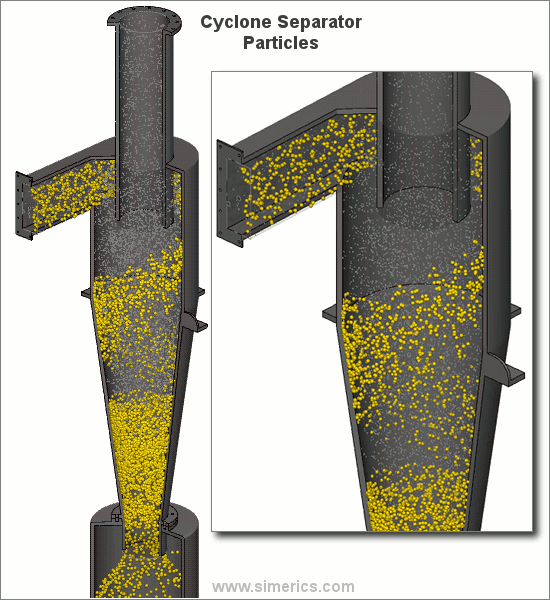Cyclone separator

Cyclone separators or simply cyclones are separation devices that use the principle of inertia to remove particulate matter from flue gases.[2] Cyclone separators are part of a group of air pollution control devices known as precleaners as they are generally used to roughly remove larger pieces of particulate matter. This prevents more fine filtration methods from having to deal with large, more abrasive particles later one. As well, several cyclone separators can operate in parallel, and when this is set up the system is known as a multicyclone.[3]
It is important to note that cyclones can vary drastically in their size. The size of the cyclone depends largely on how much flue gas must be filtered, and thus larger operations tend to need larger cyclones. For example, several different models of one cyclone type can exist, and the sizes can range from a relatively small 1.2-1.5 meters tall (about 4-5 feet) to around 9 meters or about 30 feet (which is about as tall as a three story building!).[4]
How It Works
In a cyclone separator, dirty flue gas is fed into a chamber. Inside this chamber exists a spiral vortex, similar to a tornado. This spiral formation and the separation is shown in Figure 2. The lighter components of this gas have less inertia, so it is easier for them to be influenced by the vortex and travel up it. Unlike these particles, larger components of particulate matter have more inertia and are not as easily influenced by the vortex.[2]

Because these larger particles have difficulty following the high-speed spiral motion of the gas and the vortex, the particles hit the inside walls of the container and drop down into a collection hopper. These chambers are shaped like an upside-down cone to promote the collection of these particles at the bottom of the container. The cleaned flue gas escapes out the top of the chamber.
Most cyclones are built to control and remove particulate matter than is larger than 10 micrometers in diameter. However, there do exist high efficiency cyclones that are designed to be effective on particles as small as 2.5 micrometers. As well, these separators are not effective on extremely large particulate matter. For particulates around 200 micrometers in size, gravity settling chambers or momentum separators are a better option.[3]
Out of all of the particulate-control devices, cyclone separators are among the least expensive.[2] They are often used as a pre-treatment before the flue gas enters more effective pollution control devices. Because of this, cyclone separators can be seen as "rough separators" before they reach the fine filtration stages.
Effectiveness
Cyclone separators are generally able to remove somewhere between 50-99% of all particulate matter in flue gas.[2] How well the cyclone separators are actually able to remove this matter depends largely on particle size. If there is a large amount of lighter particulate matter, less of these particles are able to be separated out. Because of this, cyclone separators work best on flue gases that contain large amounts of big particulate matter.
There are several advantages and disadvantages in using cyclone separators. First, cyclone separators are beneficial because they are not expensive to install or maintain, and they have no moving parts. This keeps maintenance and operating costs low. As well, the removed particulate matter is collected when dry, which makes it easier to dispose of. Finally, these units take up very little space. Although effective, there are also disadvantages in using cyclone separators. Mainly, the standard models are not able to collect particulate matter that is smaller than 10 micrometers effectively and the machines are unable to handle sticky or tacky material well.[3]
References
- ↑ Wikimedia Commons. (July 16, 2015). Cyclone Separator [Online]. Available: https://upload.wikimedia.org/wikipedia/commons/e/e3/Cyclone_separator.svg
- ↑ 2.0 2.1 2.2 2.3 R. Wolfson. Energy, Environment and Climate, 2nd ed. New York, U.S.A.: Norton, 2012
- ↑ 3.0 3.1 3.2 US EPA. (July 16, 2015). Air Pollution Control Technology Fact Sheet [Online]. Available: http://www.epa.gov/ttncatc1/dir1/fcyclon.pdf
- ↑ Kice. (July 22, 2015). CK Cyclone Collectors [Online]. Available: http://www.kice.com/pdfs/CK_Cyclones.pdf
- ↑ Simerics. (July 21, 2015). Cyclonic Separator [Online]. Available: http://www.simerics.com/animation/cyclone_ani.gif

